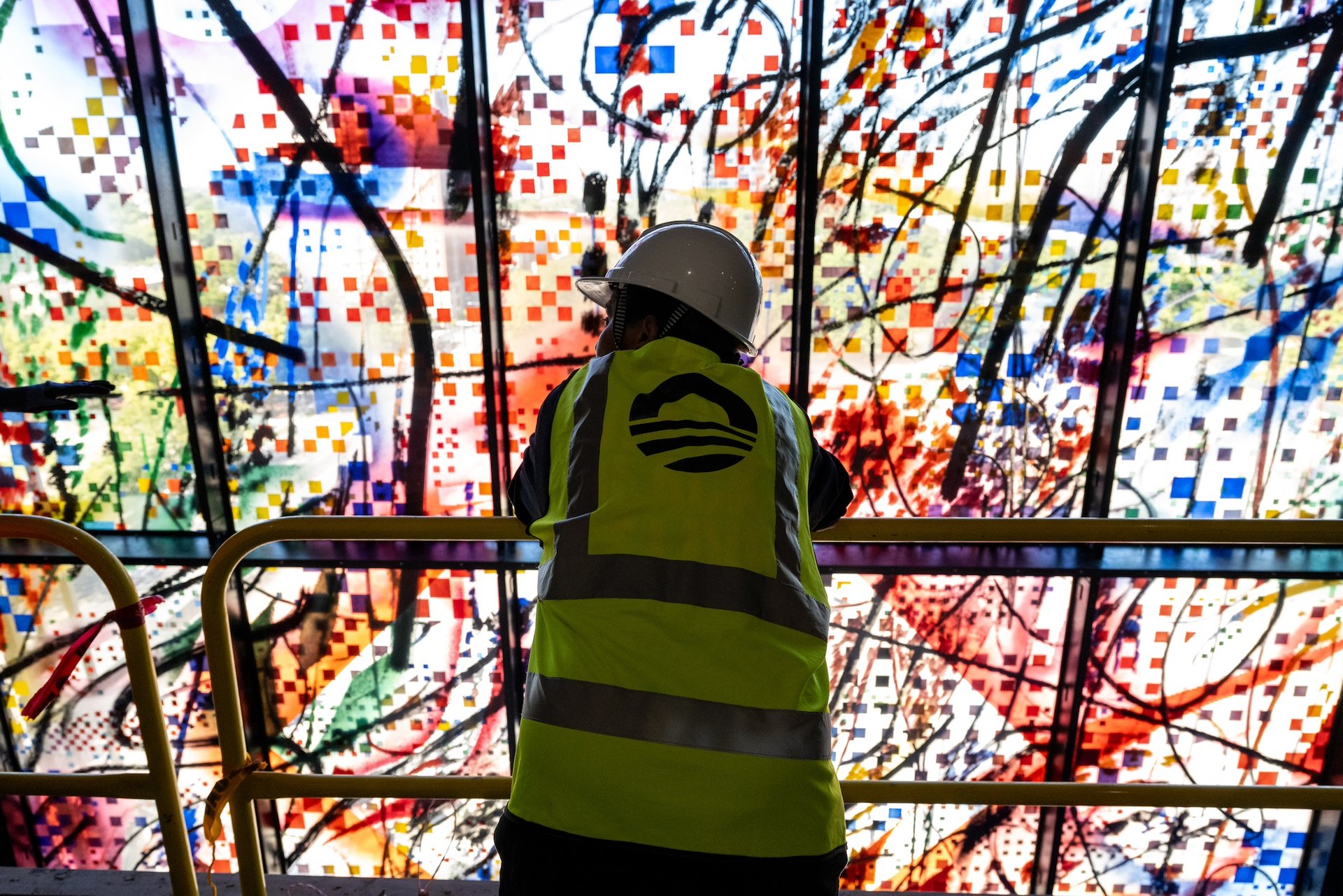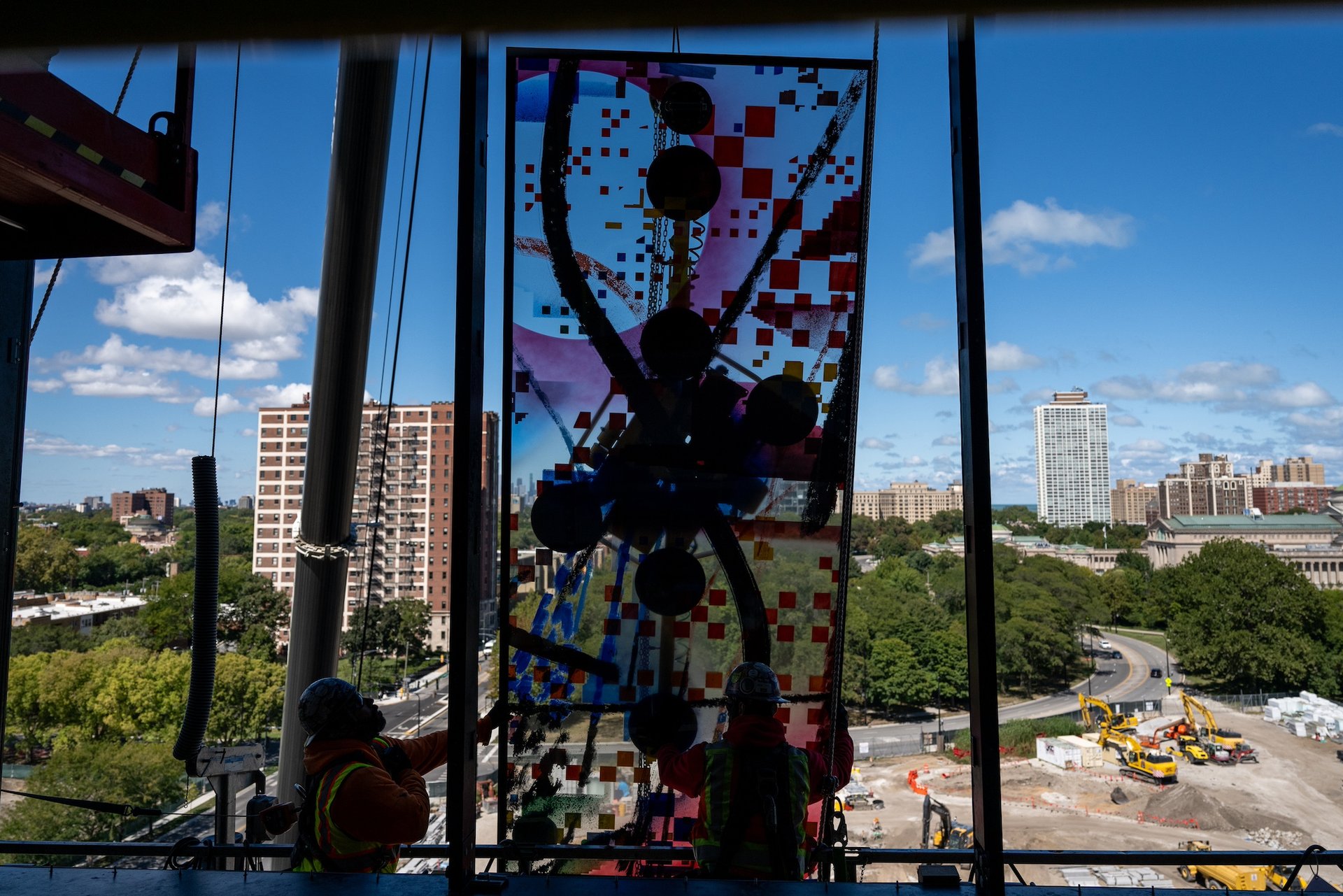The ambitious Obama Presidential Center (OPC) in Chicago, designed by Tod Williams Billie Tsien Architects, broke ground in 2021. Recently the main building, an angular granite-clad tower that will house the museum, began to take shape and was being readied for the centre’s most imposing art commission—a monumental painted glass window by Julie Mehretu.
On Saturday (7 September), specialists began installing the 35 panels that comprise Uprising of the Sun (2024), an 83ft-tall and 25ft-wide abstract work, on the north facade of the building.
The level of intention in the centre’s design and layout is evident in the names of the spaces and buildings; for instance, its public plaza will be named after one of former president Barack Obama’s heroes, the late civil rights icon and former congressman John Lewis. Mehretu was moved not only by the OPC’s attention to history, but by the promise of a space devoted to inspiring visions for the future. “I wanted to honour Chicago’s history and president Obama’s legacy by telling a story about how change happens,” she says.
Mehretu’s massive window is informed largely by the importance of the Civil Rights movement in the US and is in concert with another architectural feature of the centre—a passage from Obama’s 2015 speech in Selma, Alabama, that will wrap around one corner on the façade’s south side. The speech was given on the 50th anniversary of the march from that small southern town to the state capital of Montgomery in support of voting rights for Black citizens. The marchers were brutally attacked by police (a young John Lewis suffered a cracked skull) as they crossed the Edmund Pettus Bridge.
“I really wanted to come up with a cohesive concept,” says Mehretu, who is known for painting large-scale, poetic abstractions that get at big ideas using a rich variety of references and source material. Working with glass for the first time, and on a scale that was daunting, the fabrication was out of her hands. Mehretu collaborated with the Franz Mayer Studio in Munich.

Artist Julie Mehretu tours the Obama Presidential Center site during the installation of her commissioned artwork, the 83ft-tall painted glass window titled Uprising of the Sun, in Chicago on 7 September Courtesy The Obama Foundation
For Uprising of the Sun, Mehretu began with an image of Obama and Lewis crossing the bridge together during the anniversary ceremony. She had many other sources of inspiration in mind, including the 19th-century landscape painter Robert S. Duncanson’s Land of the Lotus Eaters (1861). Duncanson, a free person of African descent, was celebrated in his time, then forgotten for decades. The painting depicts a passage from Homer’s Odyssey and references a poem by Alfred Lord Tennyson. Mehretu says that Duncanson understood the sublime. The lush masterpiece resonated with her for many reasons including its immensity and aspiration.
“That is one conceptual layer,” she says.
Mehretu took the Obama and Lewis image and blurred it into the Duncanson painting. Using various digital mapping and design tools she flattened that merged and altered work into the Jacob Lawrence screenprint Confrontation on the Bridge (1975), which also depicts the events at Selma. Mehretu also studied Lawrence’s The Migration Series(1940-41), depicting the mass movement of Black Americans from the rural South to the urban North beginning in 1915 and known as the Great Migration.
Mehretu also had in mind the great modernist Africa Hall in Addis Ababa, built for the United Nations Economic Commission for Africa in her native Ethiopia. Mehretu was born in Ethiopia in 1970 and moved to the Midwest as a child when her Ethiopian father took a teaching position in the economics department at Michigan State University in 1977. Mehretu’s mother is American. Africa Hall contains a giant stained-glass window designed by the Ethiopian artist Afewerk Tekle. For Mehretu, that stained glass, which she visited as a child, was unforgettable. “It was in my head,” she says.
“I kept going back to these things,” says Mehretu, referring to the photograph of Obama and Lewis, the works by Duncanson and Lawrence, and Africa Hall. “All four are somehow embedded in the piece.”
She also thought about her relationship to Chicago. Mehretu considers the Art Institute of Chicago and the Detroit Institute of Arts as formative institutions in her development as an artist. She grew up midway between the two cities, both of which became great cultural hubs in part thanks to the Great Migration.
Layering imagery and history
The layers, shapes, colours and linear dynamics in Uprising of the Sun are imbued with history and meaning. From the inside, visitors will be able to look out at the cityscape in the distance. “When you are looking out at those vistas it is not just some pristine space,” Mehretu says. “It is informed by layers of history.”
Mehretu, who is based in New York, made a quick trip to Chicago on Saturday to witness the installation. Because of the work’s size, Mehretu had not been able to see it in its entirety. She created the piece in quarter scale.

Artist Julie Mehretu tours the Obama Presidential Center site during the installation of her commissioned artwork, the 83ft-tall painted glass window titled Uprising of the Sun, in Chicago on 7 September Courtesy The Obama Foundation
The verticality of Uprising lends itself to another big idea, which is the motif of the Ascension in Western art history. Mehretu was also thinking of the large Buddhist caves in the East. Uprising faces an escalator where visitors will be ascending. It speaks to a place which will offer more than traditional presidential libraries of the past, and to the idea of transformation—a space designed to inspire future leaders.
Mehretu did not title the piece until it was complete. She was thinking how Uprising was really a painting about light. (The colour will only be seen when it is properly illuminated.) She wanted the words “ascension” and “light” in the title, but nothing was working. Then she looked at the work of 16th-century metaphysical poet John Donne. A poem about the sun lent itself to the title, with a subtle tweak. It was also a nice symmetry to Duncanson and Tennyson.
Art plays a central role at the OPC, where the primary mission will be to serve as a hub for community and civic engagement. In addition to the museum, the 19-acre campus will contain a forum, a branch of the public library (graced with a Richard Hunt bronze), gardens and places to stroll, play, reflect and be inspired. Maya Lin was commissioned to create a sculpture with a water feature near the entrance and the other commissions, more than 20, will be announced at a later date. (The foundation is working with art consultant Virginia Shore.)

Rendering of the Obama Foundation Museum building's 83ft-tall painted glass window by Julie Mehretu Credit: Lamar Johnson Collaborative and Julie Mehretu Studio
"President and Mrs Obama believe that art is an essential part of inspiring the next generation of leaders," says Valerie Jarrett , the chief executive of the Obama Foundation. President Obama was already familiar with Mehretu’s work, and Jarrett says that when he met the artist for the first time, they clicked immediately.
“Once they agreed on a concept, she was left to do what artists do—which is create a masterpiece,” Jarrett says. “She is an extraordinary artist. She understands that her art is part of a larger story.” She adds: “Hers will be an important welcoming statement and that, coupled with the words of speech in Selma, sends a positive message of what a beacon of hope the Obama Presidential Center will be.”
The OPC has not been without controversy. A park preservationist group objected to the site in Jackson Park, which was designed by Frederick Law Olmsted on the South Side of the city and filed a federal lawsuit that delayed the project. The site is a major construction site now, but landscaping plans for the campus include recreating the demolished historic Women’s Garden, a playground designed by Michael Van Valkenburgh Associates and the planting of many trees and native plants.






